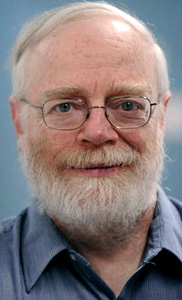

 The Internet represents a threshold moment for the communications realm in many ways. It altered the immediate end client of the network service from humans to computers. It changed the communications model from synchronized end-to-end service to asynchronous and from virtual circuits to packet switching. At the same time, there were a set of sweeping changes in the public communications framework...
The Internet represents a threshold moment for the communications realm in many ways. It altered the immediate end client of the network service from humans to computers. It changed the communications model from synchronized end-to-end service to asynchronous and from virtual circuits to packet switching. At the same time, there were a set of sweeping changes in the public communications framework...
 The IETF held its 115th meeting in London in November 2022. This was another in the set of hybrid meetings with specific support for online attendees in addition to the normal face-to-face meetings for the week. In no particular order, here are a few of my impressions from the IETF meeting.
The IETF held its 115th meeting in London in November 2022. This was another in the set of hybrid meetings with specific support for online attendees in addition to the normal face-to-face meetings for the week. In no particular order, here are a few of my impressions from the IETF meeting.
 The latest technology on the horizon is the metaverse, which, stated simply, is the creation of online environments. While the primary focus of the metaverse is to create alternate realities, an application with a possible immediate big uptake is vertical presence for business meetings. Ciena, a manufacturer of fiber optic transmission equipment, recently did a survey worldwide of 15,000 business people to understand the interests and expectations of the metaverse.
The latest technology on the horizon is the metaverse, which, stated simply, is the creation of online environments. While the primary focus of the metaverse is to create alternate realities, an application with a possible immediate big uptake is vertical presence for business meetings. Ciena, a manufacturer of fiber optic transmission equipment, recently did a survey worldwide of 15,000 business people to understand the interests and expectations of the metaverse.
 The Internet's Domain Name System undertakes a vitally important role in today's Internet. Originally conceived as a human-friendly way of specifying the location of the other end of an Internet transaction, it became the name of a service point during the transition to a client/server architecture. A domain name was still associated with an IP address, but that 1:1 association was weakened when we started adjusting to IPv4 address exhaustion.
The Internet's Domain Name System undertakes a vitally important role in today's Internet. Originally conceived as a human-friendly way of specifying the location of the other end of an Internet transaction, it became the name of a service point during the transition to a client/server architecture. A domain name was still associated with an IP address, but that 1:1 association was weakened when we started adjusting to IPv4 address exhaustion.
 Brooks is famous for many things. Many people know him best as the author of The Mythical Man-Month, his musings on software engineering and why it's so very hard. Some of his prescriptions seem quaint today -- no one these days would print out documentation on microfiche every night to distribute to developers -- but his observations about the problems of development remain spot-on. But he did so much more.
Brooks is famous for many things. Many people know him best as the author of The Mythical Man-Month, his musings on software engineering and why it's so very hard. Some of his prescriptions seem quaint today -- no one these days would print out documentation on microfiche every night to distribute to developers -- but his observations about the problems of development remain spot-on. But he did so much more.
 In August 1858, Queen Victoria sent the first transatlantic telegram to U.S. President James Buchanan. The cable system had taken a total of four years to build and used seven copper wires, wrapped in a sheath of gutta-percha, then covered with a tarred hemp wrap and then sheathed in an 18-strand wrap, each strand made of 7 iron wires. It weighed 550kg per km, with a total weight of over 1.3Mkg.
In August 1858, Queen Victoria sent the first transatlantic telegram to U.S. President James Buchanan. The cable system had taken a total of four years to build and used seven copper wires, wrapped in a sheath of gutta-percha, then covered with a tarred hemp wrap and then sheathed in an 18-strand wrap, each strand made of 7 iron wires. It weighed 550kg per km, with a total weight of over 1.3Mkg.
 I'd like to reflect on a presentation by Dr. Paul Vixie at the October 2022 meeting of the North American Network Operators Group (NANOG) on the topic of the shift to pervasive encryption of application transactions on the Internet today. There is a view out there that any useful public communications medium needs to safeguard the privacy and integrity of the communications that it carries.
I'd like to reflect on a presentation by Dr. Paul Vixie at the October 2022 meeting of the North American Network Operators Group (NANOG) on the topic of the shift to pervasive encryption of application transactions on the Internet today. There is a view out there that any useful public communications medium needs to safeguard the privacy and integrity of the communications that it carries.
Last Saturday marked the 53rd anniversary of the Internet. While the vast majority of its five billion users have been online for less than a decade, the Internet was taken into use on October 29th, 1969, when two computers connected to the ARPANET exchanged a message. Although the Internet has been around for a while, it remained below most people's radar until the late 1990s when the dot com boom started.
 OARC held its fall meeting in Belgrade on October 22 and 23. Here are my impressions of some of the presentations from that meeting... UI, UX, and the Registry/Registrar Landscape - One of the major reforms introduced by ICANN in the world of DNS name management was the separation of registry and registrar functions. The intent was to introduce competition into the landscape by allowing multiple registries to enter names into a common registry.
OARC held its fall meeting in Belgrade on October 22 and 23. Here are my impressions of some of the presentations from that meeting... UI, UX, and the Registry/Registrar Landscape - One of the major reforms introduced by ICANN in the world of DNS name management was the separation of registry and registrar functions. The intent was to introduce competition into the landscape by allowing multiple registries to enter names into a common registry.
 The recent launch of a new internet exchange point in Saint Martin has propelled the territory towards a better, faster and more resilient Internet. The French Caribbean territory's new IXP, called Smart-IX, was launched in October under the auspices of a recently launched CaribIX project, which is coordinated by the Caribbean Telecommunications Union (CTU), supported by the Caribbean Network Operators Group (CaribNOG), funded by the INTERREG Caraïbes programme...
The recent launch of a new internet exchange point in Saint Martin has propelled the territory towards a better, faster and more resilient Internet. The French Caribbean territory's new IXP, called Smart-IX, was launched in October under the auspices of a recently launched CaribIX project, which is coordinated by the Caribbean Telecommunications Union (CTU), supported by the Caribbean Network Operators Group (CaribNOG), funded by the INTERREG Caraïbes programme...